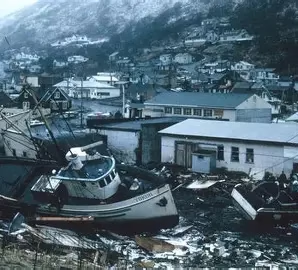Alaska Tsunami: History, Warnings, and How to Stay Safe
Alaska Tsunami: History, Warnings, and How to Stay Safe
Alaska Tsunamis
Alaska, known for its breathtaking landscapes and rugged coastlines, is also a region prone to powerful tsunamis. These seismic sea waves have impacted communities, ecosystems, and the economy throughout history. Understanding Alaska tsunamis is crucial for residents and visitors alike. In this comprehensive guide, we explore the causes, major historical events, warning systems, and preparedness strategies related to Alaska tsunamis.

Historical Alaska Tsunamis
Alaska has witnessed some of the most devastating tsunamis in recorded history. One of the most significant was the 1964 Good Friday earthquake and tsunami, which claimed over 130 lives and caused extensive damage across coastal towns. Another notable event occurred in 1958 in Lituya Bay, where a megatsunami reached an unprecedented height of 1,720 feet, caused by a massive landslide triggered by an earthquake. Smaller but still impactful tsunamis have been recorded throughout the years, affecting both populated and remote areas of Alaska’s coastline.


Causes of Alaska Tsunamis
Most Alaska tsunamis result from undersea earthquakes along tectonic plate boundaries. The Alaska-Aleutian Subduction Zone is particularly active, where the Pacific Plate dives beneath the North American Plate. Other causes include landslides, volcanic activity, and glacier calving. Each of these events can displace large volumes of water, creating tsunami waves that travel across the ocean at high speeds, impacting distant shores. With climate change accelerating glacial melt and affecting geological stability, new potential triggers for tsunamis are emerging, increasing both frequency and unpredictability.

Alaska Tsunami Warning Systems
The National Tsunami Warning Center (NTWC) plays a critical role in monitoring seismic activity and issuing timely warnings. Alaska’s residents rely on sirens, mobile alerts, radio broadcasts, and social media updates to stay informed. It’s essential to recognize the natural signs of a tsunami as well—such as strong ground shaking, unusual ocean behavior, or sudden water recession from the shore—especially in remote areas where electronic alerts may be delayed. Community outreach programs and educational initiatives have been expanded to ensure every resident understands the protocols and evacuation routes.

Safety Tips and Preparedness
Preparedness is key to surviving an Alaska tsunami. Here are some critical steps:
- Identify evacuation routes and safe zones in your community, making sure every family member knows the plan.
- Prepare an emergency kit with essentials such as water, food, medications, communication devices, important documents, and personal hygiene items.
- Participate in community drills and educate family members about tsunami risks, especially children and elderly individuals who may need assistance.
- Stay informed through official channels and act immediately when a warning is issued. Delaying evacuation can cost lives.
- Never return to the coast until authorities declare it safe, as multiple waves may occur over hours or even days following the initial tsunami.

Impact on Local Communities and Ecosystems
Alaska tsunamis not only affect human settlements but also disrupt local ecosystems. Coastal habitats can be inundated with saltwater, harming plant life and wildlife. Fisheries—an essential part of Alaska’s economy—can also suffer due to changes in marine environments. Communities that rely on fishing, tourism, and coastal industries face prolonged recovery periods. Infrastructure damage, including to roads, ports, and public services, further complicates rebuilding efforts. The emotional and psychological toll on residents should not be underestimated, as entire communities may face displacement or long-term disruption.
Scientific Research and Future Outlook
Scientists continuously study Alaska’s seismic activity and tsunami patterns using advanced technologies like GPS monitoring, ocean buoys, and satellite imagery. Research efforts focus on improving prediction accuracy and minimizing false alarms. Institutions such as the University of Alaska Fairbanks and NOAA collaborate on long-term studies, gathering valuable data to enhance global tsunami models. As climate change accelerates glacier melting and alters coastal geography, new tsunami risks may emerge, requiring ongoing vigilance and updated safety protocols. Public-private partnerships are being developed to fund resilient infrastructure projects that consider future tsunami risks and sea-level rise.

Community Stories and Personal Accounts
Many Alaskan residents have shared their experiences surviving past tsunamis, providing invaluable insights into real-world preparedness and response. For example, survivors of the 1964 event recall escaping to higher ground within minutes of the shaking, highlighting the importance of instinctive reactions. These personal stories emphasize that no amount of technology can replace local knowledge and community cohesion. By documenting these accounts, future generations can learn practical lessons and feel a deeper connection to their environment and its risks.
Staying Informed and Safe
Understanding Alaska tsunamis is essential for everyone living in or visiting this majestic yet dynamic region. By learning about past events, recognizing warning signs, and preparing in advance, individuals can significantly reduce the risks associated with these natural disasters. Staying informed through trusted sources and community programs ensures that safety remains a top priority in Alaska’s coastal communities. Building a culture of preparedness today is an investment in protecting lives, property, and the natural beauty that makes Alaska unique
https://www.tsunami.gov/ — National Tsunami Warning Center official website
Share this content:





1 comment